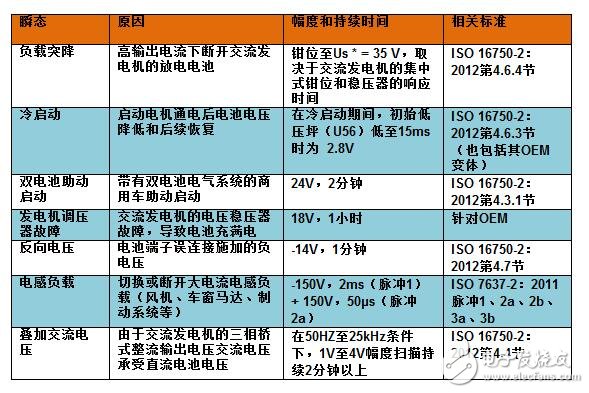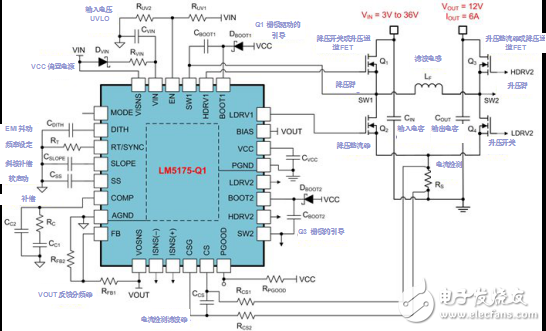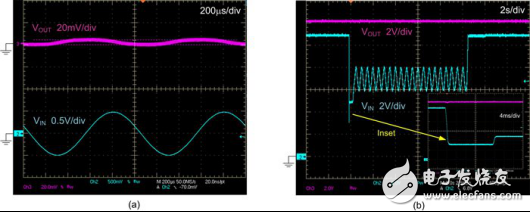Automotive batteries have a steady-state voltage range of 9V to 16V, depending on their state of charge, ambient temperature, and alternator operating conditions. However, battery power buses are also subject to a wide range of dynamic disturbances, including start-stop, cold-start, and load dump transients.
In addition to the standard pulse waveforms given by industry standards such as the International Organization for Standardization (ISO) 7637 and ISO 16750, each car manufacturer has a unique and extensive test suite for conducted immunity. Table 1 lists several transient characteristics of undervoltage and overvoltage vehicles.

Table 1: Continuous and transient conducted interference of automotive batteries and related test levels
Generator induced noiseIn the audio range, a particularly annoying source of noise is the automotive alternator, where the residual AC generated at the output causes the alternator to emit "beep" and power modulation problems. Section 4.4 of ISO 16750-2 mentioned in Table 1 describes the ripple voltage of the alternator output over a frequency range of 50 Hz to 25 kHz with peak amplitudes (VPP) of 1 V, 2 V and 4 V, depending on the test pulse severity. See Figure 1.

Figure 1: ISO 16750-2 superimposed AC voltage test (a); log frequency sweep curve from 50 Hz to 25 kHz over a two minute scan duration (b)
In many vehicles, a centralized passive circuit protection network consisting of low-pass inductor-capacitor (LC) filters and transient voltage suppressor (TVS) diodes is used as the first line of defense against transient disturbances. Automotive electronics located downstream of the protection network are rated to withstand transients of up to 40V without damage. However, the cutoff frequency required by the LC filter attenuates low frequency interference, resulting in considerable filter inductance and electrolytic capacitance. At this point, the presence of an active power stage is necessary to eliminate bulky passive filter components and provide a compact and cost-effective solution for compact voltage regulation and transient suppression.
Four-Switch Synchronous Buck-Boost RegulatorThe advantage of the wide VIN buck-boost regulator solution is its high power supply rejection ratio (PSRR), which provides excellent transient mechanics to attenuate input voltage transients. With this in mind, I recently wrote an article: "Automotive Front-End Buck-Boost Regulator Active Filtering Voltage Interference", which describes a high-density solution for automotive applications.
Figure 2 shows the schematic of a four-switch buck-boost regulator for a tightly regulated 12V rail. The solution is ideal for critical automotive functions, including drive trains, fuel systems, and body and safety subsystems, even during the most severe battery voltage transients, the load must remain powered without failure. This easy-to-use design tool simplifies the design of the regulator, resulting in faster design and time-to-market.

Figure 2: Four-Switch Synchronous Buck-Boost Solution with 3V to 36V Wide VIN Range
Figure 3a shows the output voltage waveform of a buck-boost regulator when the 9V DC input has a superimposed sinusoidal ripple with a 1V peak amplitude and a 1kHz frequency. The input ripple is attenuated by approximately 40 dB. Figure 3b shows the output voltage dropped to 3V during the cold start transient using the automotive cold start simulator for 20ms. The four-switch buck-boost converter seamlessly regulates the cold start curve.

Figure 3: Measured four-switch buck-boost converter: 9V DC input (a) ripple rejection; cold start performance (b)
to sum upWith its high supply voltage rejection ratio (PSRR), high efficiency, and low overall bill of materials cost, quad-switched synchronous buck-boost, like TI's LM5175-Q1 current mode controller, provides a way to mitigate transient interference in automotive applications. A useful solution. The buck-boost controller is certified in the automotive industry for easy integration into automotive 12V single cells and 24V dual battery systems.
Other resources:· Check out the topic "Non-conversion buck-boost DC/DC converters under the hood" in TI's 2016-2017 Power Design Workshop.
· Read “Designing front-end DC/DC conversion stages to withstand automotive transients†in TI's Analog Applications Magazine 1Q17.
· Order the evaluation module for the LM5175-Q1 Buck-Boost Controller.
· Read the ever-increasing VIN Automotive Power Solutions database in the TI Designs Reference Design Library.
E.g:
· Automotive wide VIN front-end power reference design with cold-start operation and transient protection.
· Front-end power supply reference design with cold-start operation, transient protection, and EMI filter.
A battery connection cable are the type of wire used to connect a battery to an electronic device. The are usually made of conductive material, such as copper or aluminum, and has a pair of connectors that connect one end to the positive end of the battery and the other end to the negative end of the battery.
The main function of the battery connection cable are to transmit current and electrical energy. They direct the current from the positive end of the battery through the positive connector, and then transmits it to the electronic device through the cable. At the same time, the negative connector directs the current from the electronic device back to the negative end of the battery, forming a circuit closure.
Battery connection cables are usually of a certain length and flexibility in order to provide a flexible connection between the electronic device and the battery. It may also have a protective housing to protect the cable from damage or wear.
When choosing a battery connection cable, you need to consider factors such as current transmission requirements, battery and device connector types, and cable length and material. Proper selection and use of battery connection cables can ensure a reliable connection and power transfer between the battery and the device.
Battery Connection Cable,Car Battery Wire Harness,Black Connection Cable,Battery Connection Wire Harness
Suzhou Yonghao Cable Co.,Ltd. , https://www.yonghaocable.com